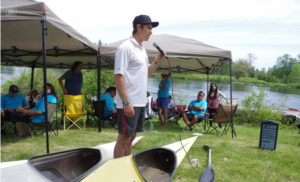Kayaker shares experiences

By Rick Garrick
THUNDER BAY—Chippewas of the Thames’ Keir Johnston, an international kayak medalist, recently shared his experiences with youth from across Nishnawbe Aski Nation territory during the NAN Summer Sports Festival.
“I’ve competed for Canada about eight times all over Europe and South America,” says Johnston, a project assistant with the Aboriginal Sports and Wellness Council of Ontario.
“I have a couple of Pan Am championship medals [from] down in Mexico and Puerto Rico,” noted Johnston.
Johnston says it was “awesome” to participate in the two Pan Am championships, where he won one silver and three bronze medals.
“It’s eye opening to see how many people are in the sport and how competitive it is,” Johnston says. “It’s great to see all the different countries, get to meet lots of new friends and travel the world. It’s a great way to do it.”
Johnston says the proper kayak stroke is all technique, so kayak competitors do not have to be “big muscular” athletes.
“A lot of people think it is all pulling with your arms, but it is actually more a full body [stroke],” Johnston says. “You really drive with your legs when you place the paddle in the water. You drive with the legs and keep the paddle parallel to your chest and use the core and rotation to bring the paddle through the water.”
Johnston’s last international competition was at the 2015 International Canoe Federation (ICF) Canoe Marathon World Championships in Oklahoma, where he finished 14th with Nigel Rockett of Toronto in the Senior Men’s K2. The two-person kayak race was held over a 30-kilometre distance, which takes “just over” two hours.
“It was a tough competition,” Johnston says. “The top guys are extremely fast. We were up there with them for a little bit of the race, so it was very cool.”
Johnston has also competed in three other ICF world championships and a couple of other international regattas. He usually gets out on the water a couple of times a day during training, which includes a run or weight session between the paddling sessions.
“We paddle about 20 to 50 kilometres a day, depending what time of the year it is,” Johnston says. “We stretch as well and [do] some other maintenance to keep the body going.”
Johnston says it is expensive to get involved with competitive kayaking because a top level kayak costs from $5,000 to $6,000 and a top level paddle costs about $500. He suggests joining a canoe club to get started, noting that members usually pay a fee of about $150 per year.
“If you are getting more serious about it, you probably would want to invest in buying your own equipment,” Johnston says. “But to start out, just join a canoe club and get out paddling.”
Johnston credits his family’s involvement in whitewater and marathon canoeing for his success in international kayaking.
“I started competing in kayaking when I was 12 years old,” Johnston says. “I knew how to kayak from growing up doing it, so I was pretty competitive early on and it took off from there.”
Johnston joined a club in Toronto when he was 16 after making the junior national team.
“We’ve got a lot of the top guys training out of that club, so it is really good,” Johnston says. “We go against each other every day. It’s a very competitive group of guys so we like to push each other. And we’re all a good group of friends too.”


